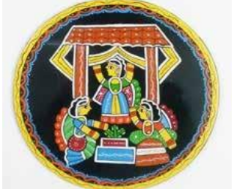About Sona Art,
"India’s multiple indigenous art forms are important sources of livelihood and empowerment for their artisans. Tikuli, an artform from Bihar, is a perfect example of empowering the state’s women artisans. Artist, craftsman, and painterShreeAshok KumarBiswas has devoted his time to reviving this craft form. He, along with his wife Shibani Biswas, revived the art and took it to a whole new level by developing it into a source of livelihood. Biswas learnt the craft from one LalBabu Gupta, a descendent of the family which specialized in the craft He has fused the tikuli craft with another art form of Bihar, Madhubani, to make decorative wall plates, coasters, table mats, wallhangings, trays, pen stands and other utility items. Tikuli art now serves as an economic beneficiary for over 3000 women in Bihar.
Since 1993, Biswas has trained more than 2,500 women, mostly from economically weaker sections of society. He got a state award
for reviving the art form. The noble efforts of the Biswases and the workmanship of these women are nationally and internationally acclaimed. In 2012, Ashok
was selected to participate in the Bihar Divas Celebrations organized in Delhi and Jaipur and an international fair in Seoul."
"The “Tikuli’ or Bindi’ which has adorned the forehead of Hindu women for centuries, has now found a new incarnation as an art form, thanks to the
efforts of Shri Upendra Maharathi and Shree Ashok Kumar Biswas. Having its origins in Patna city, this ancient craft of the Mughal times,
involved melting glass, adding colors, tracing patterns out of it and embellishing it with gold leaves and gems to create the “Tikuli” or bindi.
Post industrialization, this art suffered a severe blow and the “Tikuli” was replaced by cheaper machine-made bindis. After being in oblivion for decades, the art of making tiki is showing signs of resurrection as an art as well as a good business proposition for poor families ofBiharvillages.The only difference now is that instead
of embellishing the foreheads of Indian women, tikulis are adorning drawing room walls and tables not only in various parts of India but countries across the globe. This painting is done on the glazed surface of hardboard plates. The illustrations in the paintings depict Indian culture and mythology like Ramayana, Mahabharata and other epics. The process of making these paintings is very tedious and time-consuming. From cutting the hardboard in different sizes to painting sharp black lines in one stroke for smoothness and fineness, the process involves 15 stages. Fine brushes and enamel paints are used to make these paintings. These paintings are available in different sizes and shapes and are heat proof and water proof and are used for interior decorations like wall hangings and utility itemslike table mats and coasters."





